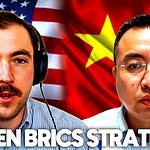It's a question loaded with fear, hype, and sensational headlines. But what if the biggest threat to the US dollar isn't China, Russia, or even BRICS itself, but rather the dollar's own weaponization?
Some say a new BRICS currency is coming. Others claim the dollar is invincible. The truth, as always, lies somewhere in between. Let's be clear from the start: BRICS won't kill the dollar.
But that's not the real story.
What BRICS is actually doing is far more dangerous to US dominance. They're not aiming for a clean kill—they're building an escape hatch. And the Global South is already crawling through it.
The 2022 Wake-Up Call
Let's rewind to 2022. The war between Russia and Ukraine began, and the West retaliated not just with tanks and trade sanctions, but with financial weapons:
$300 billion of Russia's reserves were frozen
Russian banks were cut off from SWIFT
Russian oligarch assets were seized, even in supposedly neutral Switzerland
Suddenly, the US dollar—long viewed as the safest currency in the world—became a geopolitical tripwire.
For China, India, Saudi Arabia, Brazil, and South Africa, the message was simple: Your dollars are only safe if you behave.
That scared them. Saudi Arabia alone holds over $100 billion in US treasuries. China holds over $800 billion. What if tomorrow they're the ones out of favor?
This wasn't theory anymore. This was a trigger that launched the Global South into a new era of de-risking from the dollar.
The BRICS Currency Fantasy
Every few months, someone floats the idea that BRICS is creating a new global currency backed by gold or oil. Even Russia's President Putin has hinted at it.
But here's the truth: It's not happening. Not anytime soon.
The political and technical hurdles are enormous:
Political Challenges:
BRICS is not a unified bloc
India wants strategic autonomy
China remains cautious
South Africa balances Western ties
Brazil under Lula moves slowly on monetary coordination
Technical Obstacles: To build a functioning currency, you need:
Free convertibility
Deep, liquid bond markets
A reliable exchange rate mechanism
Centralized monetary authority
BRICS has none of this. The euro took decades to build, even among culturally and economically similar nations. BRICS is trying to do it with countries spread across four continents, speaking different languages, and often competing for influence.
So will BRICS kill the dollar with a new super currency? No.
But that's not their play.
The Real Strategy: Death by a Thousand Cuts
What BRICS is doing is far smarter than trying to replace the dollar with a single new currency. They're dismantling the system the dollar controls, one piece at a time.
The real battle is happening below the surface:
India and Russia now settle some energy trade in rupees
China and Brazil signed a deal to settle trade in yuan
Saudi Arabia is selling oil to China in renminbi
ASEAN countries are launching local currency frameworks
The point isn't replacing the dollar—it's ending the need for it.
In 2023, over 20 countries expressed interest in joining BRICS+, most from the Global South. The reason? They want alternatives: trade without SWIFT, investment without dollar dependency.
Building the Infrastructure: Enter M-Bridge
You can't change global finance with politics alone. You need infrastructure. That's where M-Bridge comes in.
Built by China, Thailand, the United Arab Emirates, and Hong Kong, this multi-central bank digital currency platform is a blockchain-based system that lets countries settle trade in digital currencies directly, instantly, and without SWIFT.
In its 2022 trial, $22 million in cross-border payments were processed by 20 commercial banks using digital currencies issued by the participating central banks.
This isn't theoretical. This is the plumbing of a new global system being laid in real time, designed for a world where the dollar is optional.
Why Not Just Rally Behind the Chinese Yuan?
Because China doesn't want it.
Making the renminbi a global reserve currency would force China to:
Fully open its capital markets
Allow currency convertibility
Risk, inflation, and asset bubbles
Lose control of domestic economic levers
That's not how China operates. As economist Gao Bei puts it, turning the renminbi into a global reserve currency could turn an "exorbitant privilege" into an "exorbitant burden."
Instead, China's strategy is targeted: use it where it benefits China, avoid where it doesn't. This hybrid approach lets them chip away at the dollar without inheriting its liabilities.
The Challenge of Coordination
BRICS isn't unified enough to replace the dollar quickly. At the 2023 BRICS summit in Johannesburg:
India opposed any mention of de-dollarization in the final communique
South Africa refused to include it on the agenda under US pressure
Brazil talked big but offered little action
Only Russia (under sanctions) and China seem fully committed
With recent expansion including Iran, the UAE, Egypt, and Ethiopia joining in 2024, and Indonesia and other partners in 2025, the challenge of coordination is even harder. It's no longer just BRICS—it's becoming a United Nations of the Global South.
Consensus will be slow. Action will be uneven. But over time, the pressure will build.
The Numbers Don't Lie
Right now, the US dollar still dominates:
58% of global forex reserves
88% of forex trades
42% of SWIFT payments
But those numbers are slipping. In 2001, the dollar made up 71% of reserves. Every year, a little more trade settles in other currencies.
The IMF predicts that by 2028, BRICS+ will account for nearly 38% of global GDP compared to just 28% for the G7. That economic weight gives leverage.
And with enough leverage, you don't need to kill the dollar. You just stop needing it.
The Real Future: Irrelevance, Not Death
Here's what most analysts miss: The dollar won't go down in flames. There won't be a grand funeral. Instead, it will fade in relevance, especially in the Global South. It will lose its monopoly, not its existence.
Think of it like Microsoft—once dominant, still relevant, but no longer the only game in town. That's the future of the dollar.
And BRICS is accelerating it, not through revolution, but through evolution.
The Bottom Line
Can BRICS really kill the dollar? No, but they don't have to.
The real danger for the dollar isn't replacement—it's irrelevance. The longer the US uses its currency as a weapon, the more the world finds ways to live without it.
BRICS isn't building an empire. They're building exits:
One bilateral trade deal at a time
One digital ledger at a time
One quiet workaround at a time
And if you think that's not a threat, think again. The slow unraveling of dollar dominance is already underway, happening not through dramatic confrontation, but through the quiet construction of alternatives.
The question isn't whether BRICS will kill the dollar—it's whether the dollar will kill itself through its own weaponization.
This analysis draws from research by professors Gao Bei, Ding Yifan, and Paolo Nogueira Batista Jr., leading experts on global finance, political economy, and BRICS strategy, whose work reveals the hidden mechanics behind the headlines.










